Northern Ireland political editor
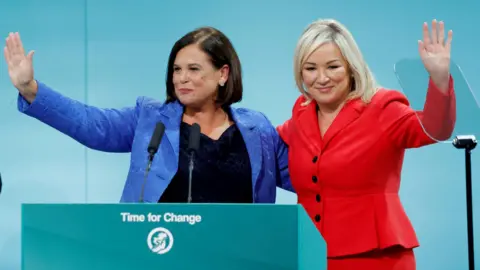 Reuters
ReutersThe Sinn Féin leadership is to meet later to work out a plan for the Irish Presidential election.
The party’s Ard Chomhairle, made up of its political leaders and delegates from regional branches, is expected to study the findings of an internal consultation on its election strategy.
Members have been considering a range of options, including entering the race or supporting an agreed opposition candidate.
No date has yet been set for the presidential election, but it needs to be held before 11 November when Michael D Higgins’ 14-year term in office officially ends.
The Sinn Féin leadership will need to look at four different puzzles to solve its presidential question.
Supporting the left-wing unity candidate
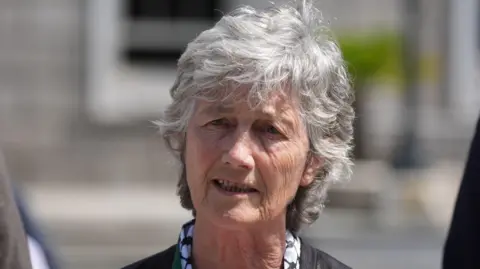 PA Media
PA MediaBut back then, the independent Senator Frances Black was being tipped as the opposition unity candidate and she would have been a popular choice for Sinn Féin supporters.
The former singer tabled the bill which seeks to ban Irish trade with illegal settlements in Israeli occupied territories, which has the full support of Sinn Féin.
But in June, Black ruled herself out of the presidential race.
Now independent TD (member of the Dáil) Catherine Connolly is hoping to secure the backing of Sinn Féin and other left-wing parties.
That could be a test for the Galway TD, who has less of a profile and may struggle to unite the opposition benches.
But if those parties plan to present themselves as an alternative government in the next election, can they really afford to divide in what could be their first electoral test?
Running a Sinn Féin candidate
This may now be the prefered path for the party leadership, but it comes with many risks.
The last time Sinn Féin fielded a candidate in a presidential election it didn’t go well.
Former party MEP Liadh Ní Riada secured just over 6% of the vote when she challenged Higgins back in 2018.
It was a disastrous showing for the party and raised questions about the leadership strategy.
After a disappointing general election in 2024, Sinn Féin and its leader Mary Lou McDonald can’t really afford another poor day at the polls.
The personality based nature of a presidential election could also be a concern as it can be a bruising contest for candidates.
They are subjected to more scrutiny across their public and private lives and it can leave long-lasting damage.
There is also the cost of running a presidential election campaign, estimated to be more than €400,000 (£349,000), coming so soon after the financially draining general election.
But, the party may consider the prize to be worth the price.
Selecting the right candidate
This will be the moment of truth.
If the party is to mount a big challenge then it will likely field its best candidate – its own leader.
McDonald hasn’t ruled herself out of the race, but has much to consider before adding her name to the ballot paper
Northern Ireland’s First Minister Michelle O’Neill, who is the party’s deputy leader, also remains in the frame along with Donegal TD Pearse Doherty.
Other names mentioned include former party leader Gerry Adams, who was back in the public eye following his recent successful defamation case against the BBC.
He has the profile, but at 76 may lack the energy for a campaign and could struggle to capture the mood of a changed electorate hoping for a younger head of state.
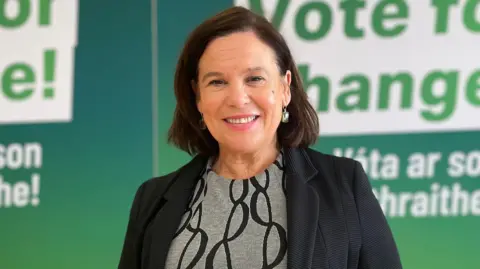 PA Media
PA MediaBelfast North MP John Finucane ticks that box, and is considered a credible candidate who is a formidable campaigner and will perform well in the all-important TV debates.
Though he might take some convincing, according to some within the party.
Risks for Mary Lou McDonald running for president
After a second failed attempt in the 2018 election to enter government, many believed McDonald’s days as Sinn Féin leader were numbered.
The last thing she wanted or needed was another poll on the horizon.
But a presidential election could present the party leader with the perfect exit ramp from the political stage.
The symbolism of a Sinn Féin leader moving into Áras an Uachtaráin (the Irish presidential residence) would be huge for her party, and the campaign for Irish unification would have a new chief cheerleader.
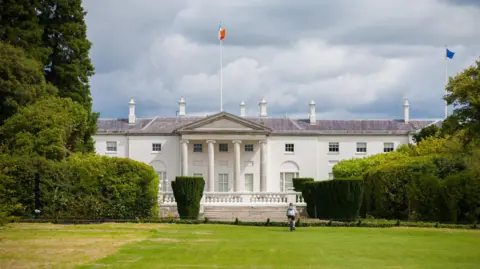 Getty Images
Getty ImagesBut if she ran and lost, it would leave the party and McDonald with a big decision to make – return to the political fold or retire.
Opting against contesting the election may be an easier choice for the Sinn Féin president now she has managed to steer the party back up the poll ratings.
She clearly has much more to offer and remains her party’s greatest asset, which is why she may stick with the presidential role she knows best.
Who else is running for president of Ireland?
With the keys to the Áras up for grabs, people from all over the political spectrum will be looking to become the Republic of Ireland’s 10th president later this year.
The office is a mostly ceremonial role
In order to be considered a candidate, a person must be an Irish citizen, over 35 and be nominated by at least 20 members of the Oireachtas (Irish Parliament) or four of the 31 local authorities.
So far, Catherine Connolly has announced her bid for the presidency, along with former EU Commissioner Mairead McGuinness, who will contest the election for Fine Gael – a decision set to be ratified by the party in September.
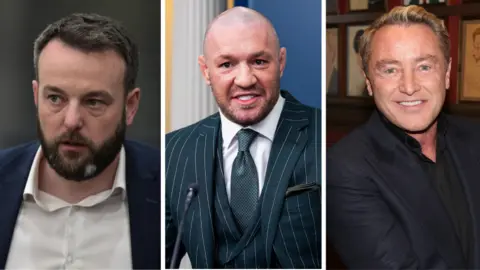 Getty Images
Getty ImagesThe largest party in the Dáil, Fianna Fáil, has not run a presidential candidate since Belfast-born Mary McAleese won the 1997 election.
The party is still considering it’s choices.
Academic Deirdre Heenan has been tipped as a potential candidate for the party.
Former Social Democratic and Labour Party leader and Foyle MP Colum Eastwood has also not ruled himself out of the running.
Entrepreneur Peter Casey, who was born in Londonderry, came second in 2018 with 23.1% of the first preference vote in 2018 and is seeking the nomination once again.
Some celebrity candidates have also said they are interested in running, with Riverdance star Michael Flatley and MMA fighter Conor McGregor both seeking backers for their respective campaigns.




